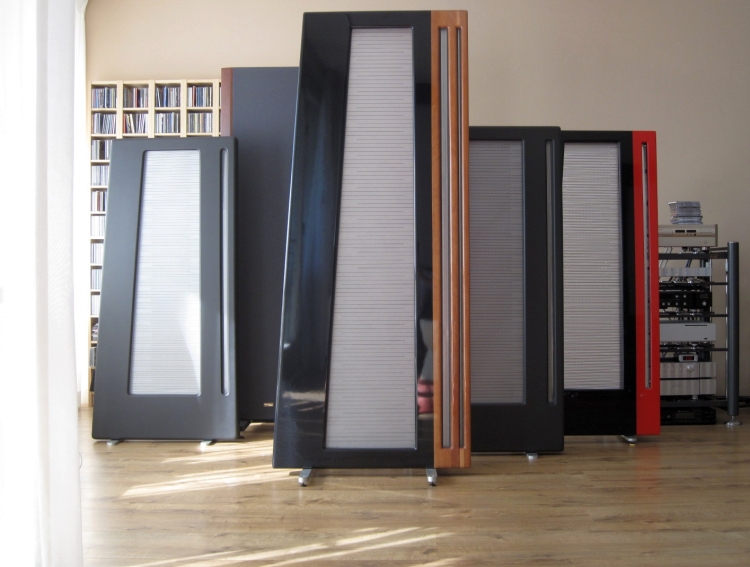
Tweaking the Bass
When comparing my Divas with the refurbished set of Duetta Sigs, while the latter have some flaws (which later turned out to be induced by the non-standard crossover), they do have much more poweful bass. This is partially a function of the different components used in the crossovers but probably mostly due to their design. The Duettas have quite a severe bass resonance that you may or may not like. I certainly don’t mind it, as it mates well with my particular room resonances and -suckouts. Even if the Divas have what is seemingly almost twice the bass radiating area of the Dueatta Signatures, they actually don’t sound bass-heavy at all. Rather, neutral and well-balanced, perhaps even a little lightweight in the bass in my initial setup at the wide end of the room.
Flashforward: my current 2014 setup has turned the Divas into the best speakers for bass that I have owned so far, and that includes the B&W 800D’s. Also, in this arrangement I don’t use subs anymore.
The Diva’s bass however is of much higher quality: it is more nimble and articulate, and it never booms. The frequency range is totally even from the lowest bass to the midbass. But boy can these speakers go low! The claimed 25hz-25khz +/-3dB is clearly no empty marketing boast. Sometimes you’re listening to neutral-sounding music and the bass doesn’t call attention to itself. Then, out of the blue, the speakers can hit very low notes with incredible power. Listening to Divas made me realise that the refurbished Duetta Sig’s bass is perhaps trying too hard. There’s at least one very big resonance peak in the Duettas bass. And this sounds very inviting at first, and that you will even miss it when it’s gone, but compared to the Diva’ bass, the Duetta’s bass is uneven, boomy and peaky. Nevertheless I still am amazed at the amount bass coming from those panels. Quite a party trick really. But to be honest, no matter how much I like it, the Refurbished Dueatta’s bass is overblown. The Diva’s bass on the contrary is perfectly balanced amd undeniably of much higher quality. It is much more like listening to headphone bass, where the room doesn’t seem to have any impact on the sound. Pretty special. The original Duetta Sigs by the way also have more bass than the Divas but unlike the Refurbished ones, they don’t boom or shout.
They don’t demand a subwoofer, but in the setup I had when I initially wrote this review, I did like to use my subs to complement the Divas as I just find that electronic music as well as R&B and rap, really do need those lowest frequencies present. My room (when the system is set up in this end of the room) has some mild cancellation in the lower regions and the subs can nicely fill them in, if carefully adjusted. In case of the Divas I have them set to 30hz: above that the speakers already take over. Wonderfully enough, the Divas are so fast that although the lower midrange is slightly more clouded, they don’t appear to slow down overall pace much when used with the subs as happened with my previous Magnepan MG3.6R’s.
But getting back to the tweaking part, I indicated above that after looking at the treble and midrange, there was one remaining area that I wasn’t entirely content with, and of course that is the bass.
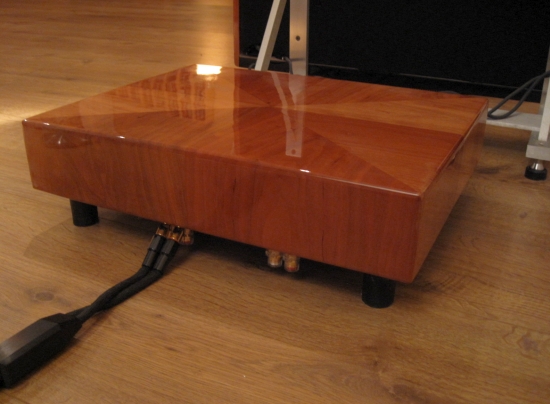
Yamaha DPS Z7 measurements
Remember how I lowered the resistor value and inverted phase on the treble ribbon to get better integration and more air in the listening spot? This was all well and good for some time, but I remained unsatisfied with the overall sound because the Duettas were better still in key areas. Of course I wanted it all. It wasn’t until I integrated my home cinema equipment into the main system and ran automated tests that I stumbled onto a discovery that would be a large leap forward.
I already became suspicious when I noticed that the Strata subs sounded louder when connected to the – terminal of the model sixes’ speaker terminals than when connected to the + terminal. These amps are true balanced and the minus side of the speaker terminal is in this case not neutral or ground but the music signal, in counter-phase. But since the subs are almost 2 meters behind the speakers, I just figured that this was acoustics-related, and after all, in the listening position, the result was good. BTW I have had the sixes for many years and used them with various other speakers and some other subs, too. Always was the + side of the terminal the one that made for the best sub integration. Preamp has always been a Rowland, with the same pin 3 = hot, and interlinks haven’t changed in many years. So the situation has been stable, only the speakers have changed. Therefore I have no reason to doubt the the following.
Recently I bought a video projector and consequently had to integrated the cinema equipment in the main listening room. Upon running auto speaker measurements using a microphone, white or pink noises and a range of frequency sweeps, imagine my surprise when the Z7 reported that the main speakers were wired out of phase! Naturally I assumed that I had made a mistake. Surely I must have fallen for that old XLR-pin3=hot thing? Nope, it wasn’t that. The wiring was absolutely right. And so was the Yamaha. After I reversed the phase for the bass foils the Yamaha reported proper phase and I was stunned at the improvement in sound! Bass was now a lot fuller and the whole sound had greater propulsion. Still the Divas were no Duettas in terms of all-out bass slam or PRAT, but their timing was now much improved and bass was almost enough for this bass-junkie. Almost, yes. In this setup I still want the Strata subs to play along, but only at low level, and cut off above 30hz.
Tweaking part 5 – Tweeter phase reversion reversed
After I originally had reversed the tweeter ribbons wires, and later found that the bass panels also had to be reversed, the thought had entered my mind that perhaps treble was correct in the first place, and midrange was not. After all, the main thing was that midrange and treble were not aligned, which I initially corrected by reversing the treble. And indeed: some more experimenting building on the now corrected bass brought to light that the midrange was also not correct. Once it was reversed, it was clearly more seemless with the bass and snare sounds were now more lively. But with the bass and midrange reversed, of course the treble problem in the sweetspot returned. After reconnecting the treble in the original fashion (colour coding correct, according to original schematic), the Divas now produced a sound that I was very content with. Overall, the bass and midrange reversal resulted in a much livelier speaker, now on par with the original Duettas, if not with the refurbished Duettas.
So, it seems that in the end the tweeter ribbons were the only ones that were wired correctly. Both bass and midrange panels had to be reversed for perfect phase alignment, best integration and coherence and fullest, most dynamic bass behaviour.
Questions questions
The big question that comes to mind is why Apogee would design the speaker this way? We know that the correct values were used in the refurbishment, and the polarity was not inversed for any of the foils. Judging from the other 3 or so pairs of Divas I have heard, both passive and active, I can conclude with certainty that I found the upper most treble (above ~10kHz) to be toned down, and this must be a design decision for whatever reason, probably frequency linearity. The bass and midrange phase however, remains a mystery. But for me at least, as well as for everyone who visited, the sound was now optimal.
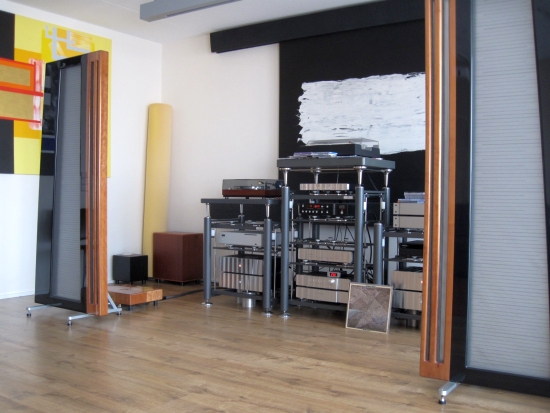
System setup rotation
After my friend JW had installed the friendliest-sounding Duetta Sigs in his listening room with bass-to-die-for as a result, I bit the bullet and rotated my setup 180 degrees. Previously, the speakers were set up on the widest side of the room, with the sofa in the narrow end, and now it was the other way around, with the speakers positioned in the 5-meter wide area. First trying this arrangement with only the bare necessary components instead of the whole system I knew within the first half of the first track I played: Bingo! The bass was… in a word: groundbreaking! Never before had I experienced such an effortlessly coherent, deep, tuneful and powerful bass. And to think that it was coming off a ribbon speaker! Trust me when I say that I am not exaggerating: even my most bass-loving huge loudspeaker using friends concurred that this was the best bass they ever heard in my room. It was in this setup that I have been most impressed with the Divas and all was good for the longest time, and everyone who visited, commented on how good my sound was.
Everyone? Well, one lone listener put up resistance.
Tweaking part 6 – Tweeter resistor value revisited
Remember what I wrote earlier, about not having enough knowledge of crossovers? It turned out that I had miscalculated the combined parallel and series values of the resistors, which led to A: me thinking that the treble was initially set to a much lower value than even the lowest value setting of the original crossovers and B: choosing a much too low value which did nicely filled in my perceived lack of treble air, but also caused some havock. Even today I don’t possess the crossover knowledge to precisely dissect the crossover and calculate responses, but it seems that with my chosen resistor value (0,4 instead of 2,9 for the “normal” setting) I likely caused a treble spike outside of audible territory, or a phase shift on the crossover point, or something like this, because ever since I installed this low resistor value, my friend JW also liked my sound, but complained about listener fatigue after having listened whole evenings in my setup.
It wasn’t until another visitor commented on speaker crossover design, telling me about the pitfalls, that I decided to finally restore the original resistor value that had been in place even after correcting the phase. Of course I knew that likely the lower resistor value wasn’t needed any longer, but it sounded so good to me and most other ears, that I never got around to removing it again.
This time I made sure that I calculated the correct value, and this time for the original “Hi” setting, along with a change in capacitor value, and presto: gone is the listening fatigue… JW is happy, and I am happy, partially. Partially because not only is the listening fatugue now gone, also is most of my precious treble air. I’m back to square one on that aspect.
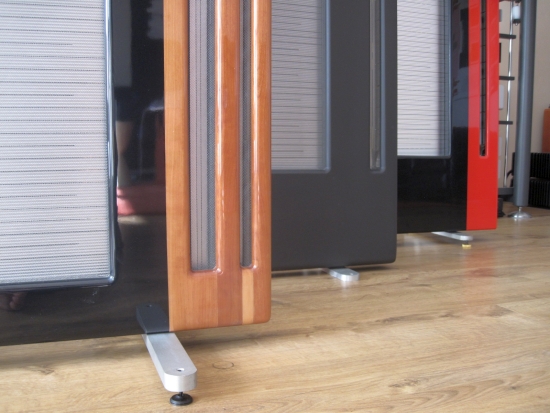
System Synergy
Divas have a very different sound balance than the refurbished Duetta Signatures, or any original set of Duettas for that matter. But bear in mind that this set of Divas differs from the standard in terms of cabling and crossover components. These babies are much more relaxed and well-balanced, so much so that they can sound restrained and undynamic if plunged into a system that was previously optimised for (Refurbished of not-) Duettas. I’ve had to carry out several seemingly small tweaks to get the balance just right again. First, I connected proper milled-from-solid-copper spades instead of the below-par bananas to the cables connecting amps to crossovers. The interesting thing was that because I had insufficient supply of the same bananas or spades, I chose to use the best ones on the bass and the lesser ones on the treble, thinking they would do least harm there. But imagine my surprise when the bass firmed up, became faster and more articulate, after I had replaced the midrange/tweeter’s bananas for the solid spades!
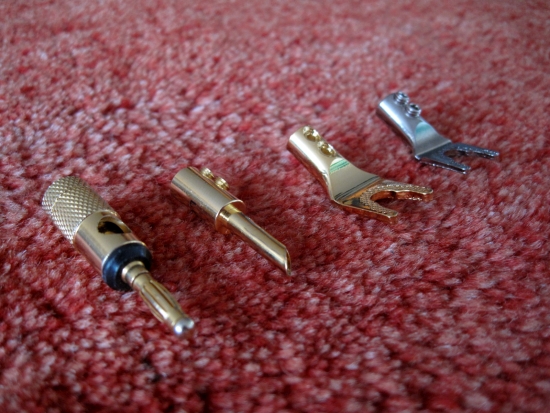
Bananas bananas spades
For the speaker-swapping-party that preceded the Diva review that you are now reading I used simple van den Hul speaker cable, with different connectors. I prefer spades but I didn’t have enough in stock so for some cables I used both spades and two versions of bananas. I know from earlier experience that some bananas are bad but I just had to take a listen. The first set of speakers were the refurbished Duetta Sigs. As I know now, they are overly dynamic and even shouty and as such, I didn’t notice the detrimental effect of the bananas. But when applying the same cables to the Divas, clearly it was a mismatch, as I quickly found out when substituting the bananas for spades.
Of course most audiophiles know that loosy connections are best avoided and so did I, but for this particular instance I figured that the damage done would not be so huge. After all: I connected the bass using excellent quality hollow bananas that have a very tight fit and used the loosy bananas on the midrange and treble. I figured if anything the midrange would lack some punch and the treble would be more airy than solid, which I actually like. But upon swapping the loosy bananas for milled-from-solid-copper spades, the difference was astounding, and not in the areas where you’d expect. The big difference was in the bass, which was now more solid, punchier, better timed and more articulate. All this without touching the actual bass cable and connectors. This explains once more that perceived improvements in one area of the spectrum can stem from changes to other parts of the spectrum. More precisely: perceived bass quality has a lot to do with the quality of the midrange. Likewise, somehow, treble air and soundstage depth have a connection with the bass quality and depth.
With reinvigored spirit, reinforce by the above, I decided to vigorously test the different connectors at hand against each other. There’s the entry level (no-name) banana, the LOK Gold plated Beryllium copper hollow banana and two milled-from-solid-copper spades: one with Rhodium plating, the other with Gold plating.
The entry level bananas sound tired and unmotivated. Pace is slow, focus is suboptimal and dynamics are compressed. Switching to the LOK Gold plated Beryllium copper hollow bananas made for a huge jump in tightness, dynamics and bass articulation. Pace picked up and focus also improved. Switching to the Gold plated LOK spade made for a very similar sound, but with a slighty tilted frequency balance: bass was fuller, treble was darker. Tightness and PRAT seemed about the same, maybe a little less. But in turn there was definitely a richer, more full-colour sound, making for a more romantic presentation. Moving from Gold plated spades to Rhodium spades was almost like switching back to the LOK banana in terms of speed, dynamics and drive, but with bass and midrange fulness intact. Treble was definitely more articulate and open than with the Gold plated spade and also a notch above the Gold LOK banana. The Rhodium spade made for a slightly more business-like sound (or more neutral if you will) but the sheer openness, making for higher perceived resolution in the midrange and treble made them the best match for my system that currently uses Apogee Divas. They are less open sounding/forward than the Duettas, or Magnepans for that matter, so I’d wager that the Gold Plated spades would match better with either other pair of speakers.
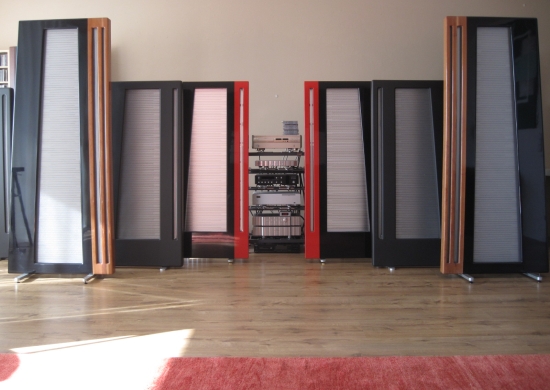
Now I was getting somewhere. Next, the model sixes were placed on Finite Elemente Cerapucs again (after I had disapproved of them in relation to the Magnepan setup), then I removed one spare Lapp cable (this alone removes some bass-blurring) and moved the pre- and power amps one position closer toward the extensionblock inlet, right next to the outlet for the subs. Also I moved the Rowland Aeris DAC in the other extensionblock one position closer toward the inlet, leaving only the AudioAanZee Ultra Flow and the Levinson CD player in front of it. Then I tightened the bottom level of the audiorack, which normally hangs freely suspended from the top. This almost brought me all the way there. I just wanted a little bit more slam and control in the bass. So I disconnected the BPSses from the sixes. Yup: tighter and a little faster, but also a lot drier and overall less romantic. The sound was now very nimble but also a little business-like. So back on went the BPSses. (mind you: I rarely switch them on; simply having them connected already has a big influence). Since I used the Transparent Reference speaker cables which are single wired I needed to bridge the biwire terminals. I tried many different cables but ultimately settled on soldering in 4mm2 installation wire from MR/HF to Bass, with the speaker cables connected to the MR/HF terminals. Then, as by accident, the final tweak brought me to Walhalla: replacing the standard spikes and cups with SoundCare super spikes.
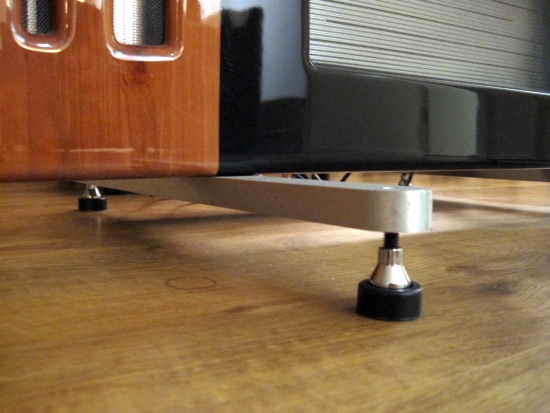
Above: SoundCare superspikes. Note that I left the nut off. I later learned that leaving this out makes the bass less tight and articulate than it can be. Even with speakers as heavy as these, it pays to support them tightly.
SoundCare super spikes
The SoundCare super spikes really were not a conscious choice but rather one born out of neccessity. You see, I did not get spikes when I bought the Divas so I borrowed the ones from the Duettas. I couldn’t source the particular size needed (5/16″) so turned to a brand from which I knew that they also made spikes for US-sourced speakers: SoundCare. Substituting the regular hardened steel spikes and Finite Elemente Spider spike bases for the super spikes made such a large difference that made JW and me stammer at each other in disbelief. How was this possible?! The bass sounded as if previously the subs were off and now they were switched on. Well, that’s perhaps overstating it. But there was really more bass using the Soundcare spikes in place of normal spikes. Not only did the bass gain mass, it also went deeper. Second: the midrange now sounded much more natural, fuller and more harmonically rich. Lastly: treble was now airier and more fluid. The effect reminded me of what the super-expensive Harmonix RF-909X Spike Bases had done for the Magnepans. But at a tenth of the price. It is not often that you come across a cheap tweak that really delivers. But this is it!
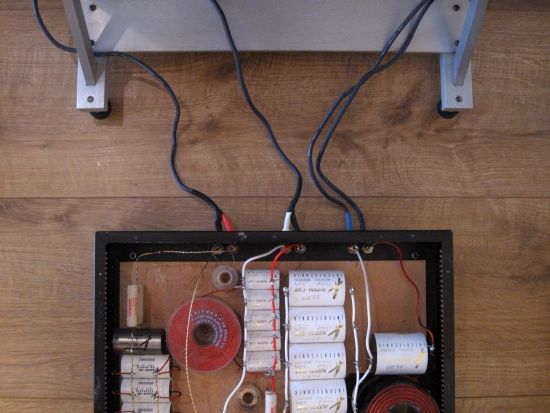
Above: Unofficial connection method used for the first part of this review. Left to right: tweeter, midrange and bass, of which the latter two are connecting “out of phase” compared to the treble and referencing the original connections.
Overall Sound – with original crossover values, but phase inverted bass and midrange
In the meantime I have also replaced the original resistors with high end Mundorf Supreme resistors of the same values, which resulted in a more organic, more dynamic and fuller sound. Apart from the upper most treble air (above ~10kHz) the Divas really are spectacular speakers. For starters: there’s not a hint of the brittleness and shouty forwardness that is present in JW’s refurbished Duetta Signatures. This is admittedly due to the non-standard Dueatta crossover, but the original Duetta Sigs also sound a little too clean, too lean in the midrange, when compared to the Divas. The Diva’s treble is pure and utterly distortion-free. I guess we can state that apparently the new Graz ribbons are not inherently metallic or rough-sounding. Oh, and on the subject of soundstage: like the Duettas, the Divas are less wide and room-filling than Magnepans. The latter always sound big, even with CD’s not recorded that way. Some people don’t like that but I quite liked it, but the way that the Divas present the soundstage is also very good, and actually more lifelike. All Apogees I heard are similar this way: they don’t sound big unless that’s a property of the recording. But you better believe the Divas can really fill the room if asked to! The Duettas were already capable of throwing a large stage but the Divas go one step further toward that live feeling. Also they do provide good layering in the depth plane, definitely on par with the Magnepans. Bringing to mind the Avalon Eclipses, I think they had even better focus, layering and staging in all directions, but they couldn’t touch the Divas’ lifelike timbre, dynamics and neutrality, let alone their thunderous bass. This narrower end of my room has some bass build up, as opposed to suckout as before, so for me this is the better trade. However there is a hint of boomyness, which I mostly cured with a large foam piece in the left corner. This will be the next point for improvement.
Dynamics
All Apogees I heard are champions at dynamic contrasts. Part of why this is the case if probably that they are very fast and make use of extremely powerful magnets. The Divas, albeit less explosive than Dueatta Sigs, are no exception.
Speaker Cables
Because the Duettas had already proven incompatible with my regular Transparent Reference XL cables, and worked so well with ordinairy van den Hul Skyline Hybrid, in the beginning I simply used the same cable for the Divas. Just like with the Duettas, the Divas sound so fabulous using this simple cable that I haven’t felt the need to change to a more highend model for the longest time. But after half a year of ownership and a lot of tweaking to the Diva’s crossovers and the system in general, I was back with my Transparent Reference (with XL technology) cables. Sure they diminish the tightness and attack somewhat but give so much back in all other departments. Now that the system is recalibrated, the Transparent cables work like a charm with the Divas, and with the Duetta’s too. There are too many tweaks to list but an important factor was that the Rowland Model 6 power amps have switches on the rear, for input impedance and for gain. When using Apogees and Transparent speakercable, these both have to be in their upper positions. This means high input impedance and high gain. There’s a separate article on this site detailing a comparison between Transparent, van den Hul and Symo speaker cables.
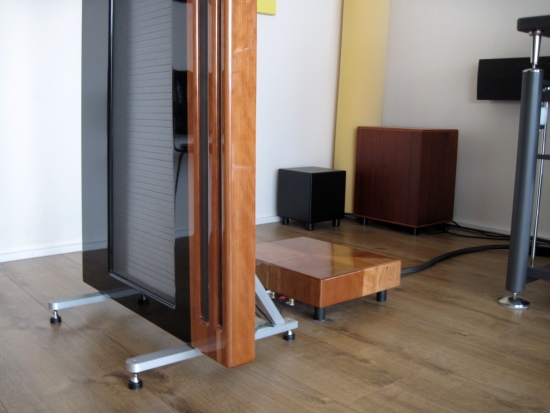
Above: there is still a sub (Rel Strata III) over there, but it is only connected to the surround amp and caters exclusively to the Z7’s LFE channel. The Quake II is only there for comparisons. I still have not made up my mind as to which one sounds better in this more limited application.
Power
The Divas go seriously loud. In fact I have not yet met their limit. The official specs state that a 100-watt amp, capable of 20 amps, is recommended. The Sixes have 150 watts and can deliver 50 Amps. As such they would seem overly powerful already but because the Divas just never run out of headroom! I suspect that they could work with even much more power without fear for breakdown. As Michel already noticed with his Divas (using 4 Rowland “Ice Power” 201’s): he can crank up the levels to his heart’s content, without any ear ache. That’s just a testament to how pure and undistorted the Divas sound. On my turn I also noticed that when I had “misbehaved” this way, that my ears never grew tired, and that it always went without any subsequent ear-ringing, as can happen with big dynamic speakers. But enough about power. Let’s discuss the finer aspects of these wonderful speakers.
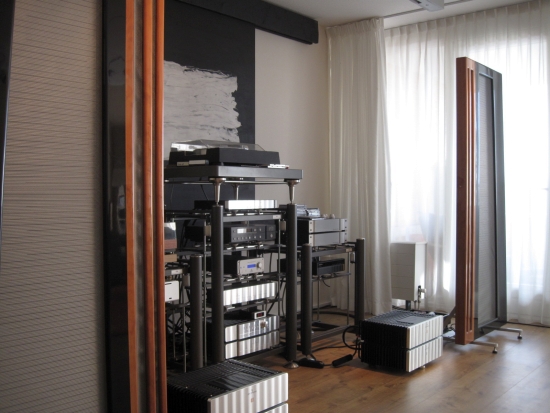
Resolution
Before reversed phase on bass and midrange, contrary to either set of Duettas (originals or refurbished), the Divas didn’t sound very open when playing very softly. They seemed to need some kick in the butt before taking off. Aferwards, the Divas now sound much more open but still they apparently like to play a little louder than the Duettas. Nothing to worry about though because I’m not talking LOUD, just not whisper-quiet, which the Magnepans actually do better, and to an extent, so do the Duettas.
But I can’t help but think that in spite of the presence of a similar true ribbon tweeter, the Divas’ low level resolution and fluidity is sligthly less impressive than that of the Magnepans. Then again, perceived resolution is often a function of treble openness, and just this area I find to be a little lacking. But to put this into perspective: the Divas don’t sound dark per se, and the Magnapans definitely had a little treble lift. I did find one review in a well know magazine where it is stated that the measured response shows a marked treble decay from around 12 kHz, in spite of the speaker’s quoted +-3dB 25 Hz-25 kHz spec. I am kind of suspecting that they measured the same thing that I heard in the sweetspot when phase was not yet reversed. Maybe someone with more knowledge about this could enlighten me?
The Diva’s treble, as well as the Duetta’s, seems to be more articulate however, more rhythmic (more accurate?) than that of the Magnepans. It might also be the case that the Magnepans sound more smeared in the treble and therefor seem to be more liquid, and conseqently, more resolving. But this is slightly nitpicking and the Divas really do have excellent treble, definitely better than any dynamic speaker I know. Overall, the Divas have very, very good coherence and resolution, but it is not up to the latest Martin Logan standard. Then again, in my opinion there’s no Logan that sounds as acoustically convincing and life-like as almost any Apogee. And they certainly don’t produce bass anywhere near challenging the Diva’s. Also, there’s more in life than treble air and overall resolution, such as midrange quality!
Midrange
Arguably the Diva’s strongest field is their midrange. Unsurprisingly perhaps, since it spans all the way from 550khz up to 12khz, so almost producing the sound of most instruments and vocals entirely in one driver. The Diva’s midrange is extremely lifelike and natural. It’s also uncolored and neutral, but not thin or threadbare nor metallic and shouty. The dynamic range is spectacular: voices are tracked with lightning speed, they can be mellow and intimate and full-on storm level but never does the midrange harden up. Voices are wholly convincing while offering much of the exciting live-feeling that I experienced with the Duetta Sigs and even more so with the refurbed ones, albeit much in a more natural manner. In comparison, the Refurbished Duettas are lean-sounding, slightly metallic and a bit shouty. I already mentioned in the Duetta review that their timbre is spot on, which is certainly true when comparing to Magnepan MG3.6, but after having heard the Divas for a week and switching to the Duettas, I wouldn’t rush to say that anymore. That’s just how superbly natural the Divas are. They make other speakers sound colored and uneven.
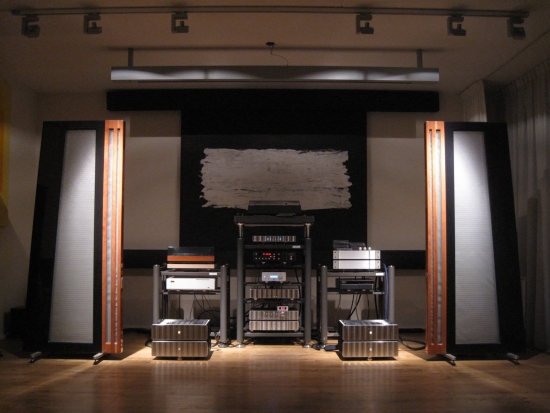
Conclusion
Like I already wrote in the Duetta review: speaker reviewers at the time weren’t wrong: Full Range Apogees really are something special. Most incredible is their bass performance: at once deep, full, dynamic and fast. While Divas don’t sound quite so full and weighty as Duettas, with the right effort in set up they still do go very deep and can pack incredible power. Play deep house tracks and you’ll be flabbergasted: what? No subs?
Even more so that Duettas, Divas are very, very neutral and natural but for all their honesty, they are never clinical or threadbare. It seems that the larger midrange ribbon, covering most part of the frequency spectrum, really delivers. I’m talking electrostatic vocal purity, minus the dynamic restraint of most electrostatics.
The separate true ribbon tweeter seems to help as well, bringing the Apogee sound closer to the treble performance of the Magnepan MG3.6R. However, the Maggies’ treble is still airier and also a little bit more refined. I think this is by design, and likely the result of the tweeter only starting as high as 11-13kHz, and not at 1,7kHz as the Magnepans do. But on other accounts it is absolutely no comparison. In my view any full range Apogee will easily win from any Magnepan, and most importantly, Divas are very, very pure and honest. Much more so than any Magnepan I’ve heard.
To some extent, Divas seem to combine the best of Magnepan with the best of themselves, to make for a speaker that is dynamic and lively as well as highly resolving and very refined. They handle all kind of music well, except perhaps for hard rock, which can sound a little too clean. That’s honesty for you I guess. They are definitely revealing but they normally don’t punish you for listening to badly recorded music.
It is important to note that, unlike Duettas, Divas don’t sound good at all if you don’t take real good care setting them up. You’ll need to invest plenty of time tweaking them (and adjusting your system to them), finding the exact spot in the room, matching electronics etcetera. By the same token Duettas also reward with better sound when tweaked with care, but they already sound impressive even if you set them up mostly wrong. Do the same with Divas and you’ll be sorely disappointed. Oh and they need good healthy power amps, much more so than the Duettas. Divas are no Scintillas, and sure you can drive them with low powered tube amps or a home cinema receiver and nothing will break. But it just won’t sound fantastic. While my Rowland sixes seem to be stable at all times driving the Divas, I can imagine that the sound could be even more solid when applying beasts of amplifiers. But I fear that they would also diminish the subtleties in sound that I am so fond of. But whatever amp you choose to use, be sure to bring high-end electronics to the table and treat the Divas with love and care and lots of patience and you’ll end up with speakers that are very, very hard to beat.
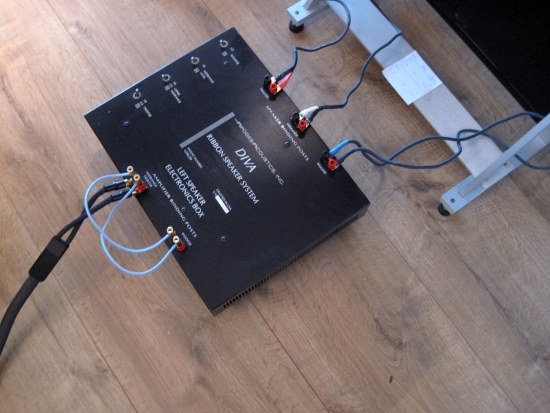
Update April 2015 – Original Crossovers
Recently I was in the fortunate position to have met a guy named Roy who also has Divas, with original crossovers. He kindly drove by with his crossovers so that we could do some comparative tests. This turned out to be very enlightning. First, it was quickly evident that my newly built crossovers had a similar sound balance and also made my Divas sound somewhat dark. Second the polarity connections for the drivers were absolutely the same as on my crossovers, meaning that the best sound for me was with bass and midrange reversed (see image above).
Interestingly the original crossovers did have slightly more treble air, and slightly better clarity through the midrange, but the price was to be paid in the bass department: sure the bass was still fine, but definitely less powerful and less voluptuous. Also timbre was more gray than with my crossovers. Much is said about the switches deteriorating, but in this case I found no evidence of this. On balance the differences were clearly audible, but my crossovers absolutely did not render the originals unlistenable. Actually, considering the cost of rebuilding these crossovers, I can imagine that it is more economical to just leave the originals as they are, and experiment some more with cables instead, to achieve a fuller sound balance.
Update April 2015 – more crossover connection tests
Official connection method
Connected as officially intended, with all plus inputs on the plus outputs, which corresponds to bass firing rearward, mid firing forward and treble firing backward when connected with a battery, the sound is most coherent. It is easy to hear that this is how the speaker is intended to play. But I also find it way too laidback that way, compared to Duettas. And most importantly, when connected this way and with the speakers having zero toe in, somehow treble is cancelled in the listening spot. I’m not sure if this is indeed a comb filter effect or simply the baffle/cover preventing wide spreading, but the only way to hear the highest treble is to either sit on axis of one speaker, or to toe them in severely. In case of using a lot of toe in, I do get sufficient treble in the listening position, but the feeling of the sound being too much laidback remains. Bass just doesn’t have any real power, and also the midrange seems withheld. I’m sure that more agressive/more forward sounding equipment might yield a different balance (not curing the treble problem though, as evidenced by visiting other people’s Diva setups), but please bear in mind that I have been using the same system with a range of Duettas as well as Centaurs and Centaur Majors and of course the Magnepan 3.6’s, and none of those speakers sounded the slightest bit laidback.
My connection method (bass and treble reversed)
My connection method however does exhibit severe comb filter effects, with peaks and throughs when moving my head horizontally over a distance of 20cm, and the treble ribbon being in wrong phase relative to the others makes for less than ideal imaging.
Input polarity
Changing polarity on the crossover input side (amp output) only makes things worse, no matter what connection method is used on the crossover output side.
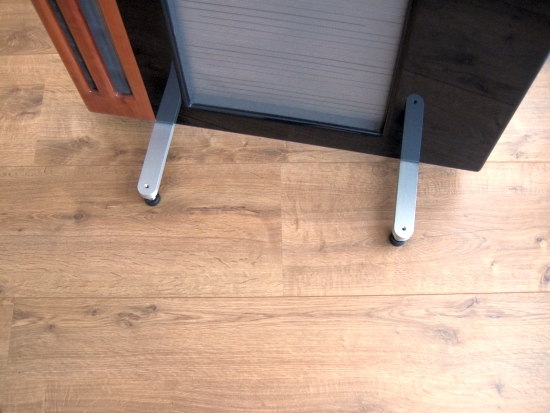
My method + treble also inverted + toe-in
After all this, one thing remained for me to try: to use my method of inverting bass and midrange at the crossover output side, but also inverting treble, meaning that all drivers are again connected essentially using the official method, but with absolute polarity for all drivers inverted at the crossover output side. Sure enough this re-introduces the treble problem, but if given enough toe in (at least 6,5cm between the speaker’s front feet with a listening distance of 470cm and the speakers 244cm apart) , the treble returns, this time prefectly integrated, and without comb-filter effects.
Why did I not try this earlier? Well, none of the other Apogees worked well with any toe in, resulting in my belief that no Apogee speaker should have any toe in. Apparently the Divas are different that way. With this much toe in however, the soundstage tends to be more confined to the speakers’ width.
So, it seems that Apogee were right in the way they connected the drivers, and Henk van der Hoeven did indeed replicate the connection method one on one. But the drivers’ relative phase to each other notwithstanding, for quite some time it remained necessary for me to invert polarity for all drivers on the crossover output side.
Lately I have reverted to normal polatity, so using the Divas entirely as they were intended. While this reduces the bass impact, it improves midrange clarity and overall coherence.
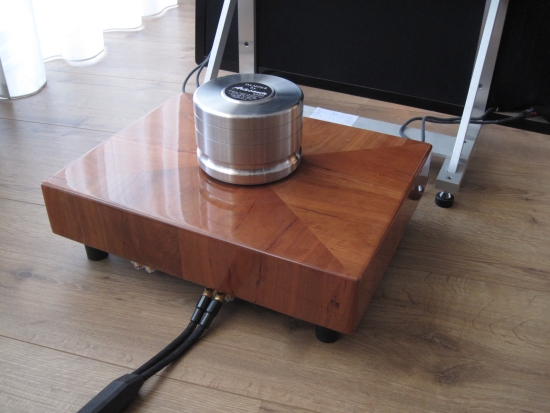
Above: a super-sized Artesania weight does an excellent job at killing resonances in the crossover boxes. The sound is audibly less boxy with these in place.
Postscript July 2016:
In speaking with Graz I later learned that the tweeter resistor value had to be changed to a lower value as part of a crossover mod, to cater to differences between the original and SLW replacement tweeters. The original value was 2,9 ohm, but according to Graz the value when using an SLW generally should be in the range of 2.25-2.5 ohms, depending on the taste of the user. It was nice to get confirmation of the validity of my desire to make changes in tweeter resistor values based on what I heard.
In closing
To clarify, while my tests and observations suggested that the phase is inverted, these findings are circumstantial and not definitive proof.
Henk confirmed that he built the crossover to the exact specifications of the original he received. He suspects that the crossover has always been incorrect, which may have been either a deliberate design choice or a factory error.
Additionally, it’s important to note that significant time has passed since these Divas were last refurbished. Henk mentioned that he has developed an updated design for the crossovers that greatly outperforms the original.
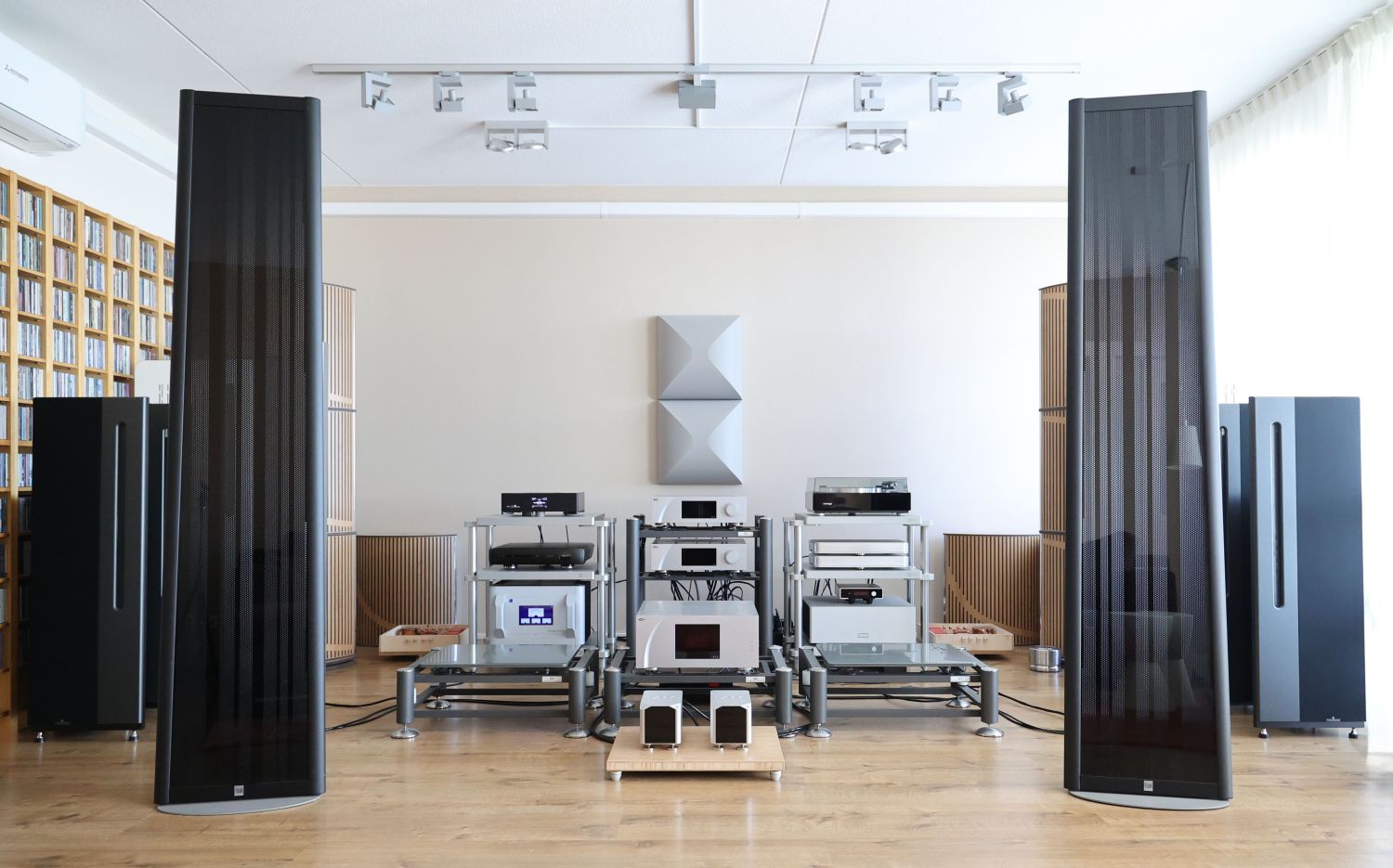
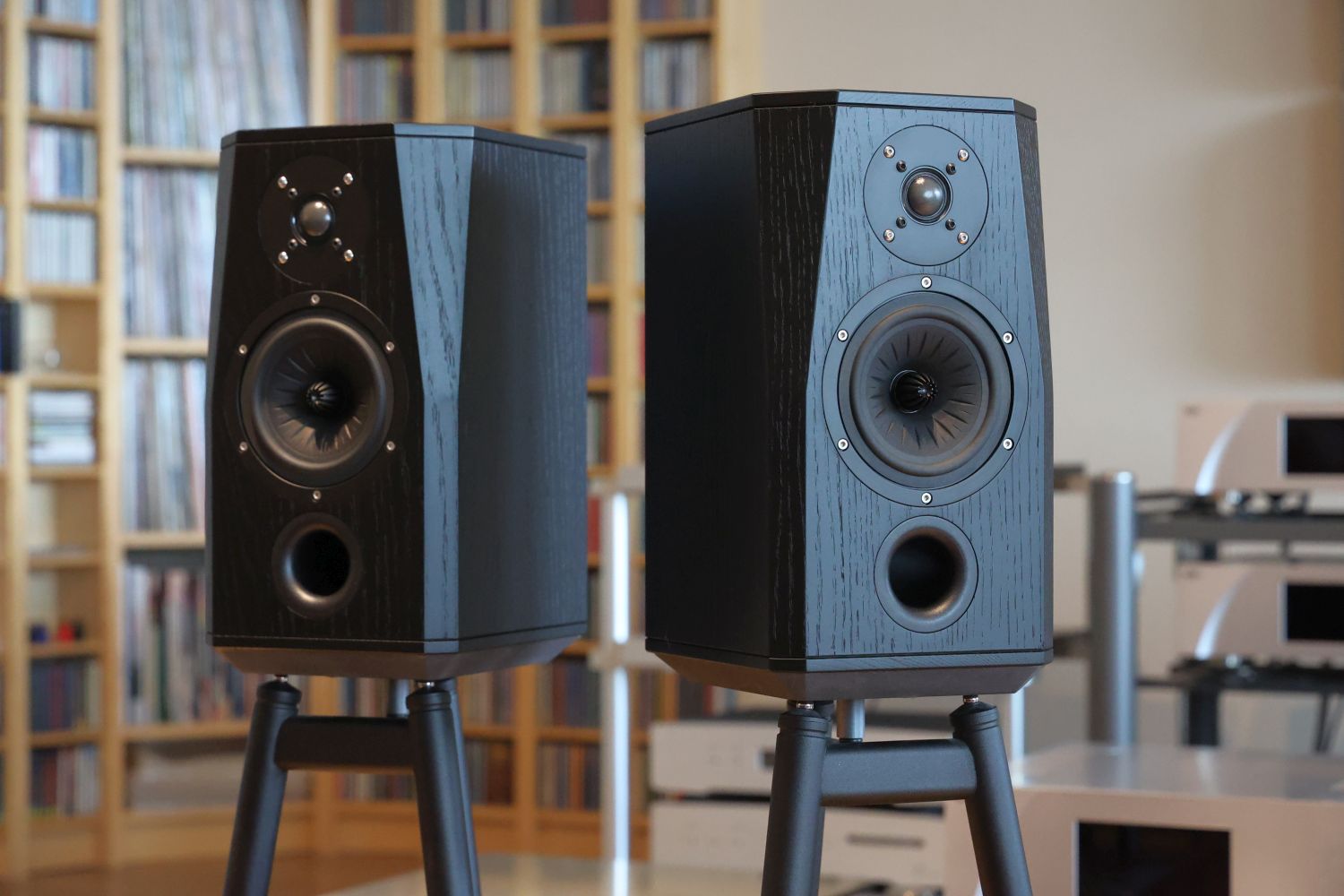
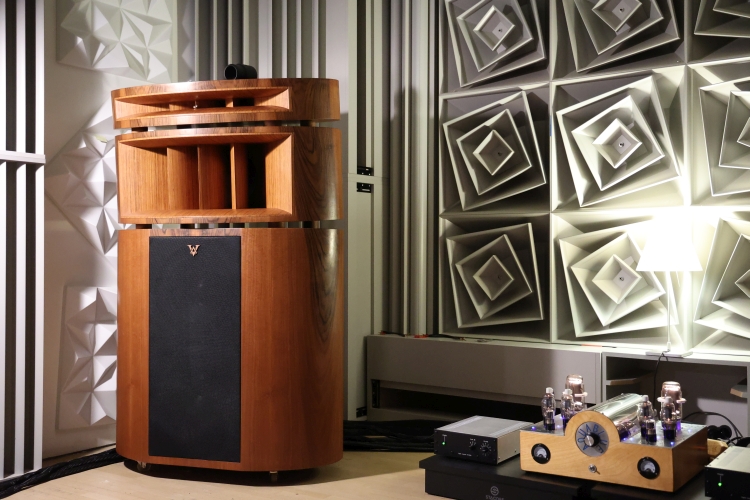
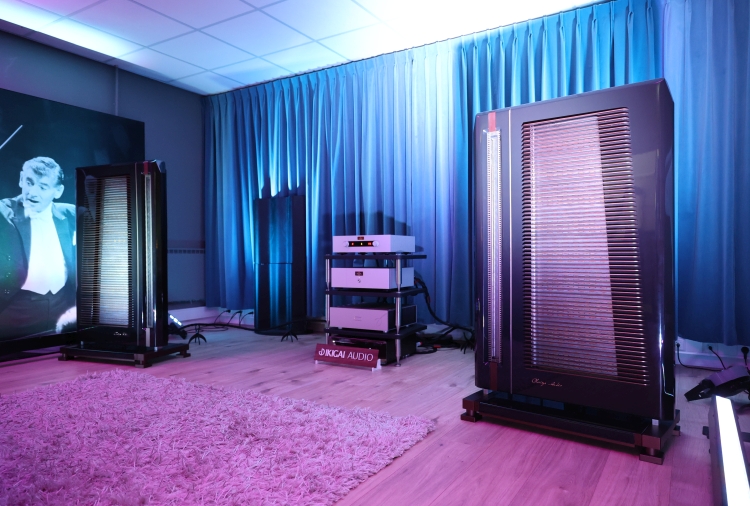
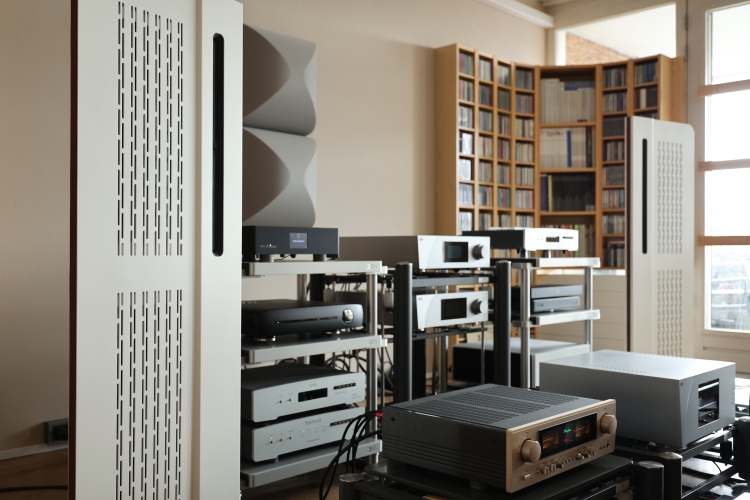
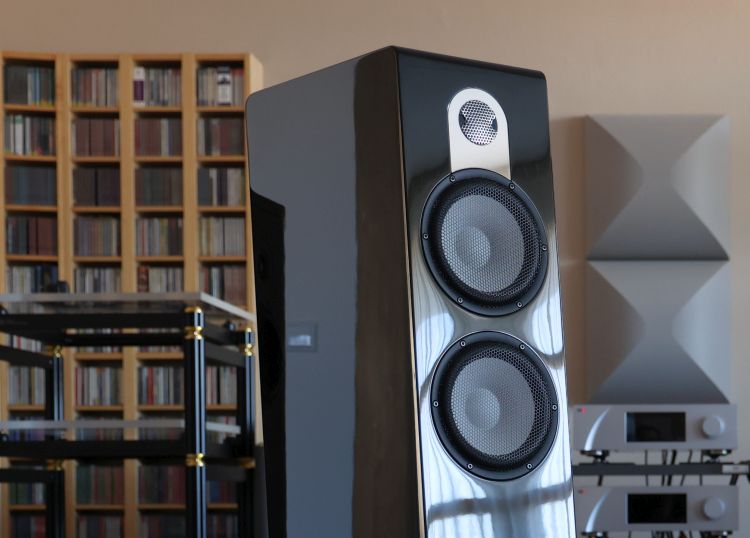
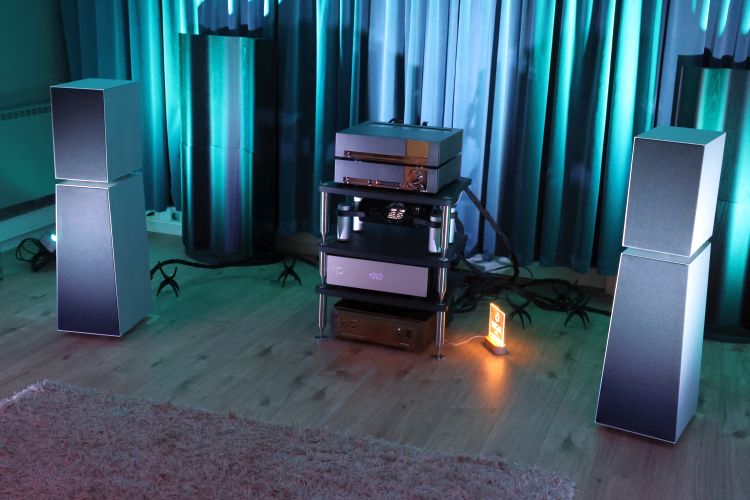
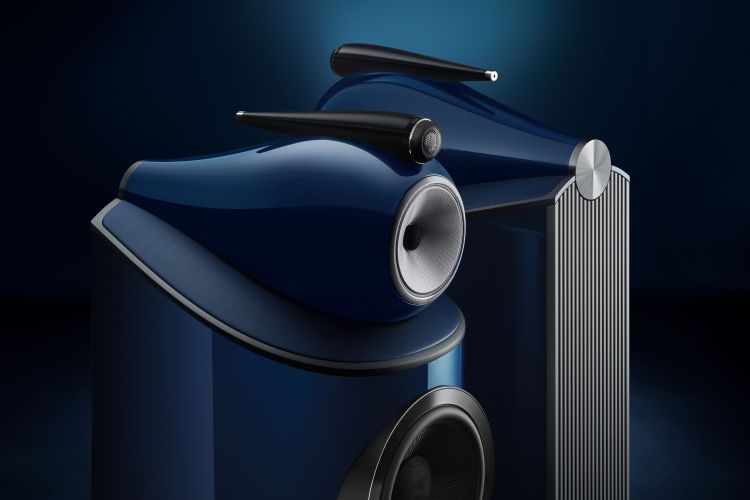
Hi Christiaan,
I have heard Henk’s Grands, one of his restored Full Ranges at his client’s in Frankfurt, one of his restored Duettas. I have also heard some of the UK restorers, and one duetta of the True Sound Works restorer (Rich Murry). I am planning to listen to two of Rich’s FRs.
I have yet to hear a properly restored Diva. If you would be so kind as to let me come over, it would be great, since I am planning to build a Duetta/Diva system with Henk’s restores.
Hi Christiaan, I hope you will be fine.
Just a little question.
How do you think JRowland Model 2 will go to drive mid and high ribbons from Diva?
Energy and current will be enough?
Have a pair of JR201 (with PFC1 module) that I would leave to bass pannel in order to biamp with Bryston active XO.
Next Tuesday I’ll test with MLogan Odyssey, but not in my home, and as I know you have a lot of experience with Rowland, maybe hel me.
Thanks
Gerard
Hi Gerard, Although I have not tried the model 2 with the Divas, I have compared 2 and 6 on B&W N804 and Martin Logan SL3. Both easier to drive than Divas, but on these speakers at least there certainly was not a world of difference between the 2 and 6. In my currrent situation though, the Diva’s bass section is usually the real power sucker. The mid and treble ribbons normally sound lively and expressive even when driven with less than adequate amps. So if you use 201s for the bass panels then I would say that indeed the two could probably effectively drive the mid and treble ribbons. Do keep in mind that the model 2 has inverting phase (pin 3 hot) and the 201’s do not (pin 2 hot), and that both have different gain. If your crossover can compensate for this then nothing stands in your way! Also see the latest update to my Audio History for a lot of info on using various amps (tube/solid state) and speakers (dynamic, hybrid and ribbon).
These look like fancy towel racks…
Dear Christiaan. I know this thread is old and not sure if you still have your Divas or not..I have a magnificent pair and am trying to learn all that is possible about the passive crossovers. I noted with great interest the following quote from one of the comments/responses to your article…I confirmed his calculation using the normal high values in the Diva tweeter crossover…I am most curious if you ever explored this? Unless I am missing something it would seem the cutover frequency to the tweeter ribbon using the stock high component values is above most peoples hearing ability? I would so much appreciate your thoughts on this…Quote below
“After study of the passive crossover diagram, I think the coil 0.01 mH at the output of the high output of the passive crossover box effects to the high freq. range. Checking the diagram by sim.okawa-denshi.jp/en/RLCtool.php, I find out the high pass freq. would be more than 25 KHz instead of 11-12 KHz. So the way to solve this problem is changing the the value of 0.01 mH to 0.045-0.05 mH. ,the high freq. would be more open and air.”
A quick update..I am begining to believe the crossover diagrams must be in error. Decimal places off maybe? I can not find any commercially available air core inductors under .1mH…The diagrams indicate the tweeter inductor value is .01mH? Truly hope someone can straighten this out..Thanks
Hi David, the official Apogee installer and restorer for the Netherlands told me some time ago that there are indeed incorrect “official” diagrams out there. What he did when making a replacement crossover, was to measure all the old components and use those values rather than the ones in the diagrams. My hearing is good but it doesn’t extend to 25kHz… I wish! Kidding aside, the tweeters definitely crossed over lower than that. I could clearly hear it when the tweeter was or was not connected and from what I heard, I would say it was indeed crossed over at about 10kHz. You’d think this wouldn’t do much for the overall sound but without the tweeters, the speakers would sound a bit dull and blunted. More like Duettas, in that respect. In terms of bass, the Duettas actually have more impact and slam (as well as a more uneven response).
Thanks. I will follow his approach. and not rely on the diagrams. The tweeter inductor value seems to be the question. Best regards
David